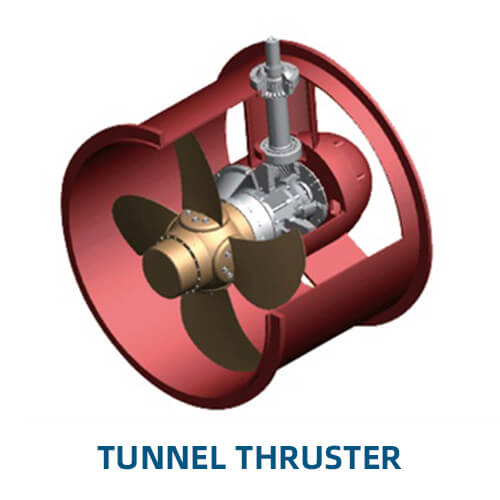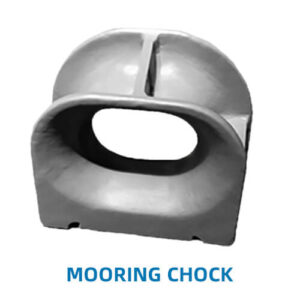Key Features of a Tunnel Thruster:
- Design and Construction:
- Tunnel: The thruster consists of a cylindrical tunnel, which is an enclosed structure that houses the propeller. The tunnel is typically mounted horizontally through the ship’s hull.
- Propeller: The propeller inside the tunnel provides thrust to push the water sideways, aiding in the lateral movement of the vessel.
- Drive System: The propeller is driven by an electric or hydraulic motor, which is housed in a separate compartment, usually located within the tunnel assembly.
- Housing: The entire assembly is built to withstand harsh marine environments and is made from corrosion-resistant materials such as stainless steel or coated steel.
- Types of Tunnel Thrusters:
- Electric Tunnel Thrusters: Powered by electric motors, these thrusters are often used in smaller vessels or where electric power is readily available.
- Hydraulic Tunnel Thrusters: Operated by hydraulic systems, these are commonly used in larger vessels where hydraulic power is more practical and efficient.
- Water-Jet Tunnel Thrusters: These use a water jet system instead of a traditional propeller to generate thrust. They are often used in high-speed vessels.
- Applications:
- Port Maneuvering: Tunnel thrusters are widely used to assist vessels in maneuvering within ports, allowing them to dock and undock with precision.
- Navigating Narrow Channels: They provide the necessary control for vessels operating in narrow or congested waterways, where traditional propeller systems may not offer sufficient maneuverability.
- Dynamic Positioning: In offshore operations, tunnel thrusters are used in conjunction with other propulsion systems to maintain the vessel’s position against environmental forces.
- Performance Characteristics:
- Maneuverability: Tunnel thrusters significantly enhance the maneuverability of vessels, allowing them to move sideways and make fine adjustments in positioning.
- Thrust Direction: The thrust produced by a tunnel thruster is directed perpendicular to the vessel’s forward motion, facilitating lateral movements and docking operations.
- Control: The thruster can be controlled independently from the main propulsion system, providing precise control over the vessel’s movements.
- Maintenance and Care:
- Regular Inspection: Inspect the tunnel thruster for signs of wear, damage, or corrosion. Pay attention to the propeller, tunnel, and drive system.
- Cleaning: Regularly clean the thruster to remove debris and marine growth that could affect performance.
- Lubrication: Ensure that moving parts, such as bearings and gears, are properly lubricated to maintain smooth operation.
- Safety Considerations:
- Operational Training: Crew members should be trained in the operation and maintenance of tunnel thrusters to ensure safe and effective use.
- Load Limits: Be aware of the thruster’s thrust capacity and ensure it is used within its operational limits to prevent damage or failure.
- Emergency Procedures: Familiarize the crew with emergency procedures in case of thruster malfunction or failure.
Advantages of Tunnel Thrusters:
- Enhanced Maneuverability: Provides superior control and maneuverability, especially in confined spaces, making docking and undocking more efficient.
- Precision: Allows for fine adjustments in positioning, which is critical in port operations and narrow waterways.
- Versatility: Suitable for a wide range of vessel sizes and types, from small pleasure craft to large commercial ships.
Considerations for Tunnel Thrusters:
- Cost: Tunnel thrusters can be expensive, both in terms of initial investment and maintenance. However, their benefits in maneuverability and control often justify the cost.
- Space: Installation of a tunnel thruster requires space within the hull, which may affect the vessel’s design and internal layout.
Tunnel thrusters are vital components for improving the maneuverability and control of marine vessels, particularly in challenging environments like ports and narrow channels. Their ability to provide lateral thrust and precise control makes them essential tools for modern maritime operations, ensuring safe and efficient vessel handling.






